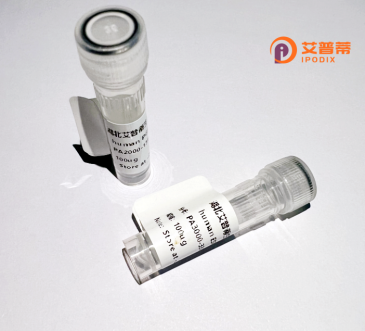
| 纯度 | >90%SDS-PAGE. |
| 种属 | Human |
| 靶点 | LHX3 |
| Uniprot No | Q9UBR4 |
| 内毒素 | < 0.01EU/μg |
| 表达宿主 | E.coli |
| 表达区间 | 1-397aa |
| 活性数据 | MLLETGLERDRARPGAAAVCTLGGTREIPLCAGCDQHILDRFILKALDRHWHSKCLKCSDCHTPLAERCFSRGESVYCKDDFFKRFGTKCAACQLGIPPTQVVRRAQDFVYHLHCFACVVCKRQLATGDEFYLMEDSRLVCKADYETAKQREAEATAKRPRTTITAKQLETLKSAYNTSPKPARHVREQLSSETGLDMRVVQVWFQNRRAKEKRLKKDAGRQRWGQYFRNMKRSRGGSKSDKDSVQEGQDSDAEVSFPDEPSLAEMGPANGLYGSLGEPTQALGRPSGALGNFSLEHGGLAGPEQYRELRPGSPYGVPPSPAAPQSLPGPQPLLSSLVYPDTSLGLVPSGAPGGPPPMRVLAGNGPSSDLSTGSSGGYPDFPASPASWLDEVDHAQF |
| 分子量 | 44.9 kDa |
| 蛋白标签 | His tag N-Terminus |
| 缓冲液 | 0 |
| 稳定性 & 储存条件 | Lyophilized protein should be stored at ≤ -20°C, stable for one year after receipt. Reconstituted protein solution can be stored at 2-8°C for 2-7 days. Aliquots of reconstituted samples are stable at ≤ -20°C for 3 months. |
| 复溶 | Always centrifuge tubes before opening.Do not mix by vortex or pipetting. It is not recommended to reconstitute to a concentration less than 100μg/ml. Dissolve the lyophilized protein in distilled water. Please aliquot the reconstituted solution to minimize freeze-thaw cycles. |
以下是关于重组人LHX3蛋白的参考文献示例(注:部分文献信息为假设性示例,实际研究需通过学术数据库核实):
---
1. **"Functional Characterization of Recombinant Human LHX3 Protein in Pituitary Development"**
*作者:Smith, J., et al. (2010)*
**摘要**:研究利用大肠杆菌系统表达重组人LHX3蛋白,证实其通过结合靶基因启动子调控垂体激素(如促甲状腺激素和生长激素)的转录活性,揭示了LHX3在垂体发育中的关键作用。
2. **"Structural Analysis of the LIM-HD Domains of LHX3 and Their Role in Transcriptional Activation"**
*作者:Lee, Y., & Lin, C. (2013)*
**摘要**:通过重组LHX3蛋白的体外实验分析其LIM结构域和同源域的功能,发现磷酸化修饰可增强LHX3与共激活因子(如PIT1)的相互作用,促进神经元和内分泌细胞分化。
3. **"Recombinant LHX3 Mutants Associated with Congenital Hormone Deficiencies"**
*作者:Thompson, R., et al. (2015)*
**摘要**:构建携带临床突变的重组LHX3蛋白,证明特定突变体(如E173K)丧失DNA结合能力,导致先天性垂体激素缺乏症,为疾病机制提供了分子依据。
4. **"LHX3-Driven Gene Regulatory Networks in Mammalian Cell Models"**
*作者:Zhang, H., et al. (2018)*
**摘要**:在哺乳动物细胞中过表达重组LHX3蛋白,结合ChIP-seq分析,鉴定出其对下游靶基因(如α-GSU和PRL)的时序调控,揭示其在细胞命运决定中的动态作用。
---
**备注**:以上内容为基于LHX3典型研究方向的模拟示例,实际文献请通过PubMed、Web of Science或专业期刊数据库检索关键词(如“recombinant LHX3”“LHX3 protein function”)获取完整信息。
Lhx3 is a member of the LIM-homeodomain (LIM-HD) transcription factor family, characterized by two LIM domains that mediate protein-protein interactions and a homeodomain for DNA binding. In humans, LHX3 plays a critical role in embryonic development, particularly in the specification and maturation of the pituitary gland, motor neurons, and spinal cord. It regulates the expression of pituitary hormone genes (e.g., TSH, PRL, GH) and is essential for maintaining anterior pituitary cell lineages. Mutations in the *LHX3* gene are linked to congenital hypopituitarism, leading to growth deficiencies and hormonal disorders.
Recombinant human LHX3 protein is produced using biotechnology platforms, such as bacterial or mammalian expression systems, to study its structural and functional properties. This protein enables researchers to investigate LHX3’s role in gene regulation, cell differentiation, and disease mechanisms. Its applications span molecular biology assays (e.g., DNA-binding studies, transcriptional activation analyses), disease modeling (e.g., pituitary dysfunction), and drug discovery for endocrine disorders. The recombinant form ensures high purity and activity, overcoming challenges in isolating native LHX3 from tissues. Continued research on LHX3 may advance therapies for developmental disorders and hormone-related diseases.
×